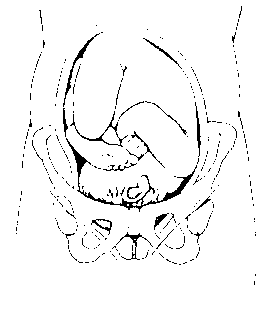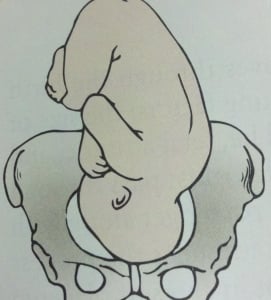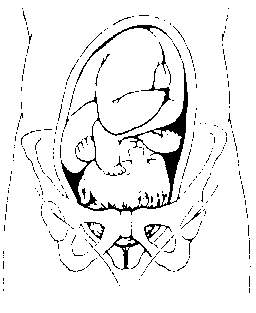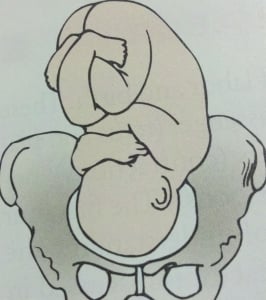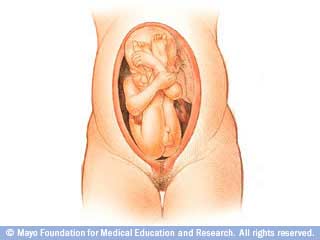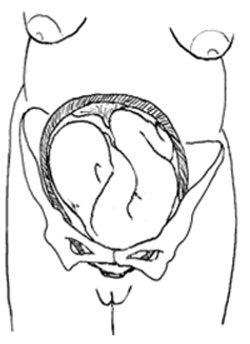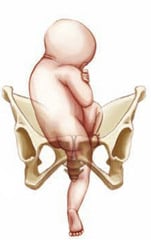Fetal Position And Presentation Quiz Questions And Answers
(533).jpg)
Hey, are you studying maternal and child health nursing concepts? Try these fetal position and presentation quiz questions and answers that we have prepared below and test your knowledge on this topic? This test consists of well-researched and intensive questions and answers that will keep you engaged till the end. You will also get to know your final score by the end of the quiz. So, if you're someone who is studying this subject or have studied it earlier, you should play this quiz and freshen up your memory!
- 1.
Determine the fetal position presented in the picture above.
- A.
Right occipitotransverse
- B.
Left occipitotransverse
- C.
Right occipitoposterior
- D.
Left occipitoposterior
Correct Answer
B. Left occipitotransverseExplanation
The correct answer is Left occipitotransverse. This means that the fetus is in a position where the back of its head (occiput) is towards the left side of the mother's pelvis, and the baby is facing towards the mother's side (transverse position).Rate this question:
-
- 2.
Identify the fetal position presented above.
- A.
Left occipitoanterior
- B.
Right occipitoanterior
- C.
Right occipitoposterior
- D.
Left occipitoposterior
Correct Answer
A. Left occipitoanteriorExplanation
The correct answer is Left occipitoanterior. This refers to the position of the baby's head in relation to the mother's pelvis. In the left occipitoanterior position, the baby's head is facing down and towards the mother's left side. This is considered the most favorable position for a vaginal delivery.Rate this question:
-
- 3.
Determine the fetal position above.
- A.
Right occipitoposterior
- B.
Left occipitoposterior
- C.
Right occipitotransverse
- D.
Left occipitotransverse
Correct Answer
A. Right occipitoposteriorExplanation
Right occipitoposterior refers to the position of the baby's head in the mother's pelvis during childbirth. In this position, the back of the baby's head is towards the mother's right side and towards the back of her pelvis. This position can make labor more difficult and may require additional interventions or techniques to assist with delivery.Rate this question:
-
- 4.
Determine the fetal position provided in the picture above.
- A.
Left occipitoposterior
- B.
Right occipitoposterior
- C.
Right occipitotransverse
- D.
Left occipitotransverse
Correct Answer
A. Left occipitoposteriorExplanation
Based on the given information, the fetal position can be determined as left occipitoposterior. This means that the baby's head is facing towards the mother's left side and towards the back of her pelvis.Rate this question:
-
- 5.
Determine the fetal presentation presented in this picture.
- A.
Shoulder presentation
- B.
Frank breech
- C.
Single footling breech
- D.
Compete breech
Correct Answer
B. Frank breechExplanation
The correct answer is Frank breech. In a frank breech presentation, the baby's buttocks are positioned to be delivered first, with the legs extended straight up towards the head. This can make delivery more challenging as the baby's head is less likely to engage in the pelvis. It is important for healthcare providers to be aware of the fetal presentation in order to determine the appropriate management and delivery method.Rate this question:
-
- 6.
Determine the fetal presentation shown in this image.
- A.
Frank breech
- B.
Single footling breech
- C.
Complete breech
- D.
Shoulder breech
Correct Answer
C. Complete breechExplanation
The image shows a complete breech presentation. In a complete breech presentation, the baby's buttocks are the presenting part, with both legs flexed at the hips and knees. The feet are close to the buttocks. This is different from a frank breech presentation, where the baby's buttocks are the presenting part, but the legs are extended straight up towards the head. It is also different from a single footling breech, where one foot is the presenting part, and a shoulder breech, where one or both shoulders are the presenting part.Rate this question:
-
- 7.
Determine the fetal presentation presented above by using the Leopold maneuvers.
- A.
Frank breech
- B.
Single footling breech
- C.
Complete breech
- D.
Shoulder presentation
Correct Answer
D. Shoulder presentationExplanation
The Leopold maneuvers are a series of four steps used to determine the position of the fetus in the mother's abdomen. In this case, the presence of a shoulder presentation suggests that the baby is positioned transversely, with its shoulder presenting first instead of the head or buttocks. This is a less common presentation and may require special medical attention during delivery.Rate this question:
-
- 8.
Determine thefetal position that is presented above.
- A.
Frank breech
- B.
Single or (double) footling breech
- C.
Shoulder presentation
- D.
Complete breech
Correct Answer
B. Single or (double) footling breechExplanation
The given answer is "Single or (double) footling breech." This means that the fetus is positioned with one or both feet presenting first, instead of the head. This is a type of breech position, where the baby's bottom or feet are positioned to come out first during childbirth.Rate this question:
-
- 9.
A student nurse is differentiating TRUE labor from FALSE labor to a 39th-week pregnant woman admitted to the labor and delivery department last night. The student nurse needs further teaching if she mentioned which of the following?
- A.
"True labor usually begins in your lower back and it may extend to your abdomen"
- B.
"There will be thinning or disappearance of the cervix during true labor"
- C.
"Ambulation will relieve your abdominal pain when you're in true labor"
- D.
"There are no cervical changes in false labor"
Correct Answer
C. "Ambulation will relieve your abdominal pain when you're in true labor"Explanation
The student nurse needs further teaching if she mentioned "Ambulation will relieve your abdominal pain when you're in true labor" because in true labor, the contractions will continue regardless of the woman's activity or position. Ambulation or movement may actually intensify the contractions. Therefore, it is incorrect to suggest that walking or moving around will relieve abdominal pain during true labor.Rate this question:
-
- 10.
What are the prodromal labor signs? Select all that apply.
- A.
Lightening
- B.
Braxton Hicks contraction
- C.
Left occipital anterior position of the fetus for delivery
- D.
Cervical softening
- E.
Slight effacement
- F.
Bloody show or expulsion of the mucus plug
- G.
Nesting
- H.
Station 0
Correct Answer(s)
A. Lightening
B. Braxton Hicks contraction
D. Cervical softening
E. Slight effacement
F. Bloody show or expulsion of the mucus plug
G. NestingExplanation
Prodromal labor signs are early signs that indicate that labor may start soon. These signs include lightening (when the baby's head drops lower into the pelvis), Braxton Hicks contractions (practice contractions that can become more frequent and intense), cervical softening (the cervix becomes softer in preparation for labor), slight effacement (the cervix starts to thin out), bloody show or expulsion of the mucus plug (the mucus plug that blocks the cervix may be released, often with a small amount of blood), and nesting (a burst of energy and urge to prepare for the baby's arrival). Station 0 refers to the position of the baby's head in relation to the pelvis and is not considered a prodromal labor sign.Rate this question:
-
- 11.
The nurse practitioner described to the patient that she is 3 cm effacement. The mother was shy to ask questions to the nurse practitioner. When you went to the room and gave her towels, she asked you what effacement means. As an LPN you know that effacement means:
- A.
"It is the degree of cervical dilation which is usually 0-10 centimeters "
- B.
"it is the thinning or disappearance of the cervix during cervical dilation or labor"
- C.
"The nurse practitioner is pertaining to the fetal location in relation to the ischial spine located in your hip bone"
- D.
"The nurse practitioner is just hungry at that time, she doesn't know what she's talking about, don't worry about what she said."
Correct Answer
B. "it is the thinning or disappearance of the cervix during cervical dilation or labor"Explanation
The correct answer is "it is the thinning or disappearance of the cervix during cervical dilation or labor." This means that the nurse practitioner was explaining to the patient that her cervix is thinning and starting to open up, which is a normal part of the labor process.Rate this question:
-
- 12.
What anatomical part of the fetus is the BEST part to hear the fetal heart rate (FHR)?
- A.
The back of the fetus
- B.
The apical pulse located in the heart
- C.
Brachial artery
- D.
The popliteal
Correct Answer
A. The back of the fetusExplanation
The back of the fetus is the best part to hear the fetal heart rate (FHR) because the fetal heart is located closer to the back than to the front of the body. This allows for better sound transmission and clearer detection of the heartbeat. Additionally, the back provides a larger surface area for the placement of the Doppler device or stethoscope, making it easier to locate and listen to the fetal heart rate.Rate this question:
-
- 13.
The patient in labor is hyperventilating with a respiratory rate of 29. You are expecting that the client will have an acid-base imbalance and is in a respiratory alkalosis condition because she is releasing too much carbon dioxide outside her body. As an LPN, you would notice the patient to have which of the following presenting manifestations? Select all that apply.
- A.
Productive and persistent coughing
- B.
Dizziness
- C.
Tingling in the fingers
- D.
Pallor
Correct Answer(s)
B. Dizziness
C. Tingling in the fingersExplanation
When a patient is hyperventilating and experiencing respiratory alkalosis, they are blowing off too much carbon dioxide, which can lead to decreased levels of carbon dioxide in the blood. This can cause symptoms such as dizziness and tingling in the fingers due to the constriction of blood vessels. Productive and persistent coughing and pallor are not typically associated with respiratory alkalosis.Rate this question:
-
- 14.
When should a laboring mother begin to voluntarily push the fetus?
- A.
When the cervix is at 10 cm dilation
- B.
When the cervix is at 3 cm dilation
- C.
When the fetal station is at -2
- D.
When the fetal station is engaged
Correct Answer
A. When the cervix is at 10 cm dilationExplanation
When the cervix is at 10 cm dilation, it indicates that the laboring mother has reached the final stage of labor, known as the "transition phase." During this phase, the cervix is fully dilated, allowing for the baby to pass through the birth canal. Voluntary pushing at this stage helps to facilitate the delivery of the fetus.Rate this question:
-
- 15.
What are the FIVE symptoms of respiratory distress in the newborn? Select all that apply.
- A.
Tachypnea
- B.
Tachycardia
- C.
Pallor or dusky color
- D.
Flaring of the nares
- E.
Chest retraction
- F.
Grunting
- G.
Decreased blood pressure
- H.
Smiling and crying
Correct Answer(s)
A. Tachypnea
C. Pallor or dusky color
D. Flaring of the nares
E. Chest retraction
F. GruntingExplanation
The correct answer is tachypnea, pallor or dusky color, flaring of the nares, chest retraction, and grunting. These symptoms indicate respiratory distress in newborns. Tachypnea refers to rapid breathing, pallor or dusky color suggests poor oxygenation, flaring of the nares indicates increased effort to breathe, chest retraction signifies difficulty in breathing, and grunting is a sign of respiratory distress. These symptoms collectively indicate that the newborn is experiencing respiratory distress and requires medical attention.Rate this question:
-
- 16.
What medication should be given to the newly born child to prevent ophthalmia neonatorum from gonorrheal exposure through the birth canal in a vaginal delivery?
- A.
Pitocin
- B.
Silver nitrate
- C.
Butorphanol
- D.
Vitamin K
Correct Answer
B. Silver nitrateExplanation
Silver nitrate should be given to the newly born child to prevent ophthalmia neonatorum from gonorrheal exposure through the birth canal in a vaginal delivery. Silver nitrate is a topical medication that is commonly used to prevent eye infections in newborns caused by gonorrhea. It is applied to the eyes shortly after birth to kill any bacteria that may have been transmitted during delivery. This helps to prevent the development of ophthalmia neonatorum, which can lead to serious eye damage if left untreated.Rate this question:
-
- 17.
What are the CARDINAL MOVEMENTS of the fetus during delivery? Select all that apply.
- A.
Engagement
- B.
Descent
- C.
Flexion
- D.
Internal rotation
- E.
Extension
- F.
Restitution
- G.
External rotation
- H.
Breeching
- I.
Inversion
- J.
Eversion
Correct Answer(s)
A. Engagement
B. Descent
C. Flexion
D. Internal rotation
E. Extension
F. Restitution
G. External rotationExplanation
The cardinal movements of the fetus during delivery include engagement, descent, flexion, internal rotation, extension, restitution, and external rotation. Engagement refers to the descent of the fetal presenting part into the pelvis. Descent is the downward movement of the fetus through the birth canal. Flexion occurs when the fetus tucks its chin to its chest, allowing the smallest diameter of the head to present. Internal rotation refers to the rotation of the fetal head to align with the maternal pelvis. Extension occurs as the fetal head passes through the birth canal and the neck extends. Restitution refers to the realignment of the fetal head with the body after delivery. External rotation is the rotation of the shoulders to facilitate the birth of the anterior shoulder.Rate this question:
-
- 18.
When should we administer a pudendal block?
- A.
First stage of labor
- B.
Second stage of labor
- C.
Third stage of labor
- D.
Fourth stage of labor
Correct Answer
B. Second stage of laborExplanation
A pudendal block is a local anesthetic injection given to numb the perineum and vaginal area during childbirth. It is typically administered during the second stage of labor, which is the pushing stage. This is because the block takes effect quickly and provides pain relief specifically in the lower part of the birth canal, allowing the mother to push effectively without experiencing excessive pain. Administering the block too early in the first stage may result in the medication wearing off before the actual delivery, while administering it in the later stages may not be necessary as the baby's head is already descending and providing some relief.Rate this question:
-
- 19.
What are the FIRST signs of regional block effectiveness?
- A.
Warmth and tingling sensation of the big toe
- B.
Cool and tingling sensation of the big toe
- C.
Tingling sensation in the lateral portion of the mouth and slight dizziness
- D.
Tingling sensation in the arms and chest pain
Correct Answer
A. Warmth and tingling sensation of the big toeExplanation
The first signs of regional block effectiveness are warmth and tingling sensation of the big toe. This indicates that the anesthesia is taking effect and the nerve block is working properly.Rate this question:
-
- 20.
The nurse is applying Erythromycin on the newborn to prevent ophthalmia neonatorum. She is aware that to apply this medication correctly to the newborn, she must consider which nursing implication?
- A.
Instruct the parents that can wipe the excess medications around the baby's eye after 1 minute
- B.
Place a thin line of ointment along the entire lower lid in conjunctival sac
- C.
Irrigate the neonate's eye first with normal saline and instill Erythromycin from inner to outer portion of the lower eyelid
- D.
Inject the medication in the newborn's eye until it bleeds
Correct Answer
B. Place a thin line of ointment along the entire lower lid in conjunctival sacExplanation
The correct answer is to place a thin line of ointment along the entire lower lid in the conjunctival sac. This is the correct nursing implication because it ensures that the medication is applied directly to the eye and will be absorbed properly. Applying the ointment in this manner helps to prevent ophthalmia neonatorum, which is an infection that can occur in newborns. Instructing the parents to wipe away excess medication after 1 minute may result in insufficient absorption, irrigating the eye first is not necessary, and injecting the medication until it bleeds is not a safe or appropriate method of administration.Rate this question:
-
- 21.
When is the appropriate time to give oxytocin to the patient?
- A.
After the placenta is delivered
- B.
Before the placenta is delivered
- C.
Before laboring
- D.
If pain does not go away during laboring
Correct Answer
A. After the placenta is deliveredExplanation
Oxytocin is a hormone that helps with uterine contractions during labor and delivery. It is typically administered after the placenta is delivered to prevent excessive bleeding. Once the placenta is delivered, the uterus begins to contract and the blood vessels that were connected to the placenta are compressed, reducing the risk of hemorrhage. Giving oxytocin after the placenta is delivered helps to enhance these contractions and further reduce the risk of postpartum bleeding. Therefore, the appropriate time to give oxytocin to the patient is after the placenta is delivered.Rate this question:
-
- 22.
What are the normal Puerperium changes relating to the body of the postpartal woman? Select all that apply.
- A.
Rugae in the vagina reappears within 3 weeks
- B.
Pulse may decrease to 50
- C.
The fundus is at the level of the umbilicus after delivery
- D.
25,000 WBC count
- E.
Palmar erythema declines quickly
- F.
Pelvic muscle regain tone in 6 weeks unless diastasis recti
- G.
Abdominal muscle regain tone in 3-6 weeks
- H.
Bowel movement is expected for 2 to 3 days
Correct Answer(s)
A. Rugae in the vagina reappears within 3 weeks
B. Pulse may decrease to 50
C. The fundus is at the level of the umbilicus after delivery
D. 25,000 WBC count
E. Palmar erythema declines quicklyExplanation
During the postpartum period, there are several normal changes that occur in the body of a woman. Rugae in the vagina reappears within 3 weeks as the vaginal tissues heal and return to their normal state. The pulse may decrease to 50 due to the decrease in blood volume and cardiac output after delivery. The fundus, which is the top portion of the uterus, is expected to be at the level of the umbilicus after delivery as the uterus begins to shrink back to its pre-pregnancy size. A WBC count of 25,000 is within the normal range during the postpartum period as the body fights off any potential infections. Palmar erythema, which is redness of the palms, declines quickly as the hormone levels return to normal.Rate this question:
-
- 23.
What are the normal Puerperium changes relating to the body of the postpartal woman? Select all that apply.
- A.
Colostrum is expressed first, and then milk
- B.
30000 mL/day of urine is normal after delivery because of 40% gain during pregnancy
- C.
Chloasma and hyperpigmentation decreases
- D.
Coagulation factors postpartally increases
- E.
ESR value is elevated for the first 10 days postpartum
- F.
Hematocrit decreases because of hemodilution
- G.
They are risk for UTI
Correct Answer(s)
A. Colostrum is expressed first, and then milk
C. Chloasma and hyperpigmentation decreases
D. Coagulation factors postpartally increases
E. ESR value is elevated for the first 10 days postpartum
G. They are risk for UTIExplanation
During the postpartum period, the body of a woman undergoes several normal changes. Colostrum, which is the first milk produced after delivery, is expressed first, followed by the production of regular milk. Chloasma and hyperpigmentation, which are dark patches on the skin, tend to decrease after childbirth. Coagulation factors in the blood increase postpartally, which helps prevent excessive bleeding. The ESR (erythrocyte sedimentation rate) value, a marker of inflammation, is elevated for the first 10 days postpartum. Women are at risk for urinary tract infections (UTIs) during this time due to hormonal changes and possible trauma during delivery.Rate this question:
-
- 24.
What is the most common cause of uterine atony in the first 24 hours postpartum?
- A.
Decreased lochial flow
- B.
Full bladder
- C.
Retained placenta
- D.
Too late administration of morphine sulfate
Correct Answer
B. Full bladderExplanation
A full bladder is the most common cause of uterine atony in the first 24 hours postpartum. When the bladder is full, it can interfere with the contraction of the uterus and prevent it from properly contracting and shrinking back to its normal size. This can lead to excessive bleeding and uterine atony, which is the inability of the uterus to contract effectively. Emptying the bladder regularly after childbirth is important to prevent this complication.Rate this question:
-
- 25.
What are the objective manifestations of positive maternal-infant bonding? Select all that apply.
- A.
Eye contact between mother and infant
- B.
Exploration of infant from head to toe
- C.
Stroking, kissing, and fondling the neonate
- D.
Smiling, talking,singing and kicking the neonate
- E.
Use of exclaiming expressions
- F.
Naming the newborn as alien's child
- G.
Taking out the clothes of the infant and letting the child cry
Correct Answer(s)
A. Eye contact between mother and infant
B. Exploration of infant from head to toe
C. Stroking, kissing, and fondling the neonate
E. Use of exclaiming expressionsExplanation
The objective manifestations of positive maternal-infant bonding include eye contact between mother and infant, exploration of the infant from head to toe, stroking, kissing, and fondling the neonate, and the use of exclaiming expressions. These actions demonstrate a strong connection and affection between the mother and the baby, promoting a sense of security and attachment.Rate this question:
-
- 26.
What are the objective manifestations of positive maternal-infant bonding? Select all that apply.
- A.
Eye contact between mother and infant
- B.
Exploration of infant from head to toe
- C.
Stroking, kissing, and fondling the neonate
- D.
Smiling, talking,singing and kicking the neonate
- E.
Use of exclaiming expressions
- F.
Naming the newborn as alien's child
- G.
Taking out the clothes of the infant and letting the child cry
Correct Answer(s)
A. Eye contact between mother and infant
B. Exploration of infant from head to toe
C. Stroking, kissing, and fondling the neonate
E. Use of exclaiming expressionsExplanation
The objective manifestations of positive maternal-infant bonding include eye contact between mother and infant, exploration of the infant from head to toe, stroking, kissing, and fondling the neonate, and the use of exclaiming expressions. These actions demonstrate a strong emotional connection and nurturing behavior between the mother and infant, fostering a sense of trust and security.Rate this question:
-
- 27.
A postpartum mother feels unexplained tearfulness, feeling down and "not feeling to eat well". As a nurse, your correct response would be:
- A.
"I understand how you feel, this is normal especially if you have a bad looking child"
- B.
This is called the postpartum blues, they are normal behaviors of the postpartum mother especially 5 days following delivery"
- C.
"You don't feel well?, take a walk with your husband in the hallway with the newborn child."
- D.
"I completely understand how you feel, let me refer you to a psychiatrist, this signifies that you have dementia."
Correct Answer
B. This is called the postpartum blues, they are normal behaviors of the postpartum mother especially 5 days following delivery"Explanation
The correct answer is "This is called the postpartum blues, they are normal behaviors of the postpartum mother especially 5 days following delivery". This response acknowledges the mother's feelings and provides an explanation for them. It also reassures her that these feelings are normal and expected after giving birth, specifically mentioning the timeframe of 5 days following delivery. This response shows empathy and understanding while also providing education about postpartum blues.Rate this question:
-
- 28.
A woman who just delivered twenty four hours ago with a full term infant sleeps the whole day and needs assistance in doing activities of daily living. The nurse identified this as normal especially during the first 24 to 48 hours postpartum. According to Riva Rubin, what stage of maternal psychological adaptation is the postpartum mother in?
- A.
Taking-in stage
- B.
Taking-hold stage
- C.
Letting-go stage
- D.
Let-down stage
Correct Answer
A. Taking-in stageExplanation
The postpartum mother is in the Taking-in stage. This stage occurs during the first 24 to 48 hours postpartum, where the mother is primarily focused on her own physical recovery and is dependent on others for assistance with daily activities. She may also spend a lot of time reflecting on her birth experience and processing her emotions. This stage is characterized by a passive and dependent behavior, which aligns with the woman in the scenario needing assistance and sleeping a lot.Rate this question:
-
- 29.
What are the interventions necessary for episiotomy wounds? Select all that apply.
- A.
Provide good perineal care
- B.
Lavage the perineum with several squirts of warm water
- C.
Blot dry the perineal area without touching the anal area
- D.
Carefully wiping the perineal area from back to front to avoid contamination of the vaginal area
- E.
Drink at least 3 liters of fluids (at least 4-6 glasses of water) daily
Correct Answer(s)
A. Provide good perineal care
B. Lavage the perineum with several squirts of warm water
C. Blot dry the perineal area without touching the anal areaExplanation
The interventions necessary for episiotomy wounds include providing good perineal care, lavaging the perineum with warm water, and blotting dry the perineal area without touching the anal area. These interventions help in maintaining cleanliness and preventing infection in the wound area. Drinking an adequate amount of fluids is important for overall health but is not directly related to the care of the episiotomy wound.Rate this question:
-
Quiz Review Timeline +
Our quizzes are rigorously reviewed, monitored and continuously updated by our expert board to maintain accuracy, relevance, and timeliness.
-
Current Version
-
Feb 27, 2024Quiz Edited by
ProProfs Editorial Team
Expert Reviewed by
Farah Naz -
May 24, 2012Quiz Created by
Nursejbv21
 Back to top
Back to top



